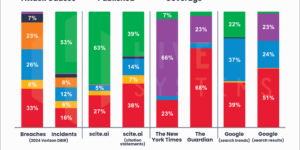Automation enhances industry, but it’s harmful to the mental health of its human co-workers.
A University of Pittsburgh study suggests that while American workers who work alongside industrial robots are less likely to suffer physical injury, they are more likely to suffer from adverse mental health effects — and even more likely to abuse drugs or alcohol.
These findings come from a study published last week in Labour Economics from Pitt economist Osea Giuntella, along with a team that included Pitt colleague Rania Gihleb, an assistant professor in the Department of Economics, and Tianyi Wang, who is in a post-doctorate program after earning his PhD at Pitt.
“There is a wide interest in understanding labor market effects of robots. And evidence of how robots affected employment and wages of workers, particularly in the manufacturing sector,” said Giuntella, an expert in labor economics and economic demography and an assistant professor in the Department of Economics in the Kenneth P. Dietrich School of Arts and Sciences.
“However, we still know very little about the effects on physical and mental health. On one hand, robots could take some of the most strenuous, physically intensive and risky tasks, reducing workers’ risk. On the other hand, the competition with robots may increase the pressure on workers who may lose their jobs or be forced to retrain. Of course, labor market institutions may play an important role, particularly in a transition phase.”
The study utilized data from workplaces and organizations on workplace injuries in the United States to find that a one standard deviation increase of robot exposure in a given regional labor market results in a reduction of annual work-related injuries. Overall, injuries were reduced by 1.2 cases per 100 workers.
Meanwhile, U.S. areas with more people working alongside robots had a significant increase of 37.8 cases per 100,000 people in drug- or alcohol-related deaths. In addition, communities working alongside robots saw a slight increase in suicide rate and mental health issues.
In addition to U.S. businesses, the researchers also investigated the effects of robotics on workers in Germany. Both countries’ employees experienced a decrease in physical injury risk with a greater exposure to robotics in the workplace, with Germany sustaining a decrease in injuries of 5 percent. Interestingly, the team found differing results regarding mental health.
While an increase in U.S. exposure to robotics resulted in more adverse mental health effects, German workers saw no significant mental health change when exposed to robotics. These findings then beg the question: Why does American automation at work seem to result in much more negative outcomes than in Germany?
“Robot exposure did not cause disruptive job losses in Germany; Germany has a much higher employment protection legislation,” Giuntella said. “Our evidence finds that, in both contexts, robots have a positive impact on the physical health of workers by reducing injuries and work- related disabilities. However, our findings suggest that, in contexts where workers were less protected, competition with robots was associated with a rise in mental health problems.”
Giuntella has studied the effects of robotics on the workforce before, with a 2021 study published in The Journal of Human Resources. This previous research focused on the effects of robotics on economic stature, marital status and marital fertility of men.
“There has been an intense debate on the effects of robotics and automation on labor market outcomes, but we still know little about how these structural economic changes are reshaping key life-course choices,” Giuntella said after that 2021 publication.
With the findings of this 2022 study, the researchers said they believe that the development of robotics can lead to even more destructive results in workers’ lives than physical injury and that labor market institutions are an important mediator of the negative effects of robots on mental health.





















 Mixed Bag: What Trump 2.0 Tariffs, DOGE Activities Mean For Insurers
Mixed Bag: What Trump 2.0 Tariffs, DOGE Activities Mean For Insurers  Safeco to Stop Writing New Condo and Renter Policies in California
Safeco to Stop Writing New Condo and Renter Policies in California  Reporter’s Notebook: ‘Nobody Else Does Telematics,’ Lemonade Exec Says
Reporter’s Notebook: ‘Nobody Else Does Telematics,’ Lemonade Exec Says  Hiring for Attitude: What Sets Lemonade Apart
Hiring for Attitude: What Sets Lemonade Apart 


